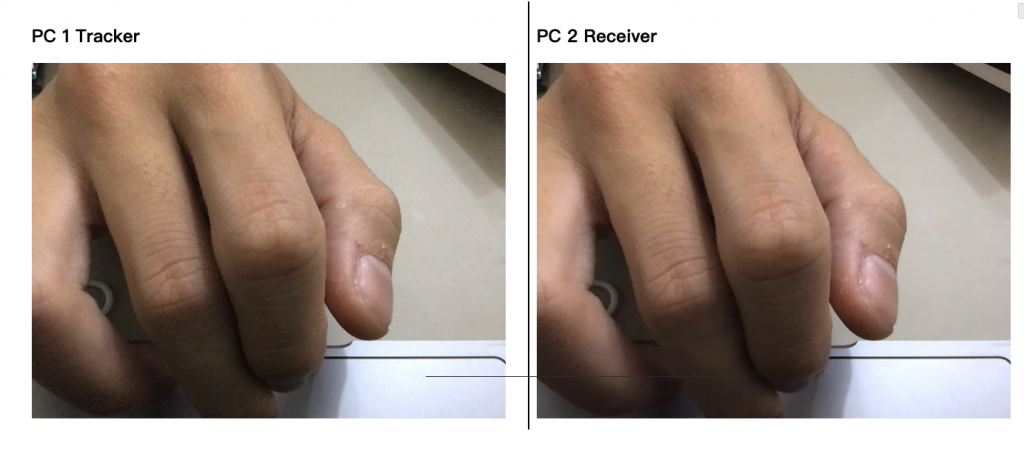因為概念資訊越來越多,我習慣先實作個簡單應用來當作入門~ (畢竟身為前端有看到畫面還是舒服一點XDD
The RTCPeerConnection interface represents a WebRTC connection between the local computer and a remote peer. It provides methods to connect to a remote peer, maintain and monitor the connection, and close the connection once it's no longer needed.
擷取自MDN
透過上述簡介,大致能了解RTCPeerConnection在 WebRTC 中扮演的角色是:
專門負責連線的建立、資料加密與頻寬管理等處理。
列舉幾項在端點連線上主要功用:
本次實作個簡易串流機制,並且功能會先實作在同一頁面,及搭配getUserMedia擷取本地端多媒體來模擬本地端與遠端間的媒體傳輸。
主要目的是藉由動手實作,來了解整個 P2P 連線的搭建過程及機制~
先附上[完整程式](Codepen
<!-- index.html -->
<!-- ... -->
<section>
<h1>PC 1 Tracker</h1>
<video id="localVideo" autoplay muted></video>
</section>
<section>
<h1>PC 2 Receiver</h1>
<video id="remoteVideo" autoplay></video>
</section>
<div class="box">
<button id="startButton">Start</button>
<button id="callButton">Call</button>
<button id="hangupButton">Hang Up</button>
</div>
<!-- ... -->
引入 JS
<script src="https://webrtc.github.io/adapter/adapter-latest.js"></script>
<script src="./js/main.js" async></script>
index.html 全貌大致上會如下
<!DOCTYPE html>
<html>
<head>
<title>RTCPeerConnection 範例</title>
</head>
<body>
<h1>RTCPeerConnection 範例</h1>
<div id="container">
<section>
<h1>PC 1 Tracker</h1>
<video id="localVideo" autoplay muted></video>
</section>
<section>
<h1>PC 2 Receiver</h1>
<video id="remoteVideo" autoplay></video>
</section>
<div class="box">
<button id="startButton">Start</button>
<button id="callButton">Call</button>
<button id="hangupButton">Hang Up</button>
</div>
</div>
<script src="https://webrtc.github.io/adapter/adapter-latest.js"></script>
<script src="./js/main.js" async></script>
</body>
</html>
實作同一頁面上模擬本機端(localPeer)及遠端(remotePeer)間的簡易串流範例。
重點: 在實作上主要有幾個大方向:
在各個 endpoint 建立RTCPeerConnection的初始化,並透過getUserMedia擷取本地端的多媒體串流。
取得與共享網路資訊:當雙方要建立 peer-to-peer 連線時,就會先依循 ICE framework 進行 IP 位址與連接埠查找的流程,來找到一個可用且最好的 candidate 來使用。
取得與交換多媒體資訊:使用 Session Description Protocol(SDP)協定的 offer 與 answer 來交換多媒體相關的資訊(例如解析度與 codec 等)
依照以上幾點,一步一步來試著建立簡易 p2p 串流:
建立 RTCPeerConnection object,並綁定onicecandidate事件,當查找到相對應的遠端端口時會做onIceCandidate callback function 進行網路資訊的共享:
let localPeer;
let remotePeer; // 初始化過程與 localPeer 相同
const configuration = {};
localPeer = new RTCPeerConnection(configuration);
localPeer.onicecandidate = (e) => onIceCandidate(localPeer, e);
localPeer.oniceconnectionstatechange = (e) => onIceStateChange(localPeer, e);
}
localPeer 藉由getUserMedia擷取並透過(addTrack)載入多媒體資訊(ex: videoTrack, audioTrack ...):
let localStream;
async function start() {
// ...省略
try {
const stream = await navigator.mediaDevices.getUserMedia({
audio: false,
video: true,
});
localVideo.srcObject = stream;
localStream = stream;
// ...省略
} catch (e) {
alert(`getUserMedia() error: ${e.name}`);
}
}
localStream.getTracks().forEach((track) => localPeer.addTrack(track, localStream));
remotePeer 初始化同上,另外能藉由綁定ontrack來接收另一端傳遞過來的多媒體資訊(videoTrack ...等),這邊用 remotePeer 做演示:
remotePeer.ontrack = (e) => {
if (remoteVideo.srcObject !== e.streams[0]) {
remoteVideo.srcObject = e.streams[0];
}
});
當 remotePeer 藉由 Signaling channel 接收到由 localPeer 傳來的 ICE candidate 時,利用addIceCandidate將其丟給瀏覽器解析與匹配,看看這個ICE candidate 所提供的連線方式適不適合。
async function onIceCandidate(event) {
try {
await remotePeer.addIceCandidate(event.candidate);
// ... handle success
} catch (e) {
// ... catch error
}
}
端點間要互相傳遞多媒體資源時必須依照SDP訂定的格式,並透過 Offer/Answer 的交換模式進行。
localPeer 用 RTCPeerConnection createOffer() method 來產出RTCSessionDescription : 也就是屬於 localPeer 的 session description。
const offer = await localPeer.createOffer(offerOptions);
建立成功後,透過setLocalDescription 將 offer 設為本身的 local description,並將其透過 Signaling channel 傳遞給 remotePeers。
remotePeer 接收到後,透過setRemoteDescription 將 localPeer 的 session description 設為自身的 remote description。
相對的 remotePeer 也必須用createAnswer method 產出 SDP 來回應 offer,步驟跟 createOffer 一樣,產出的 SDP 也要設為自身的 local description 並傳遞給 localPeer
localPeer 收到後同樣透過setRemoteDescription 將其設為自身的 remote description,如此即完成連線得作業項目,因此網路與多媒體的資訊交換可以同時進行。
// ...
try {
await localPeer.setLocalDescription(offer);
await remotePeer.setRemoteDescription(offer);
const answer = await remotePeer.createAnswer();
await remotePeer.setLocalDescription(answer);
await localPeer.setRemoteDescription(answer);
} catch (e) {
// ... catch error
}
Done !

試試看吧~
本章節了解到:
有看到畫面,至少有點實感~
在這邊可能會懞懞懂懂的,後面會開始一一講解各個 API 功用及相關概念~
新手入門,如有錯誤,歡迎指正~~~
系列文章同步更新於部落格

localPeer.onicecandidate = (e) => onIceCandidate(localPeer, e)
應該為 localPeer.onicecandidate = (e) => onIceCandidate(remotePeer, e)